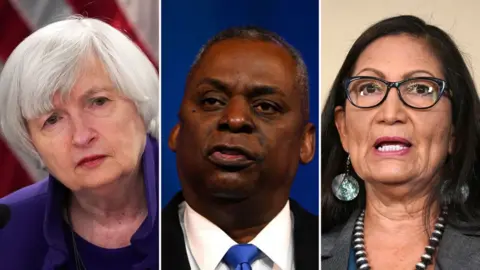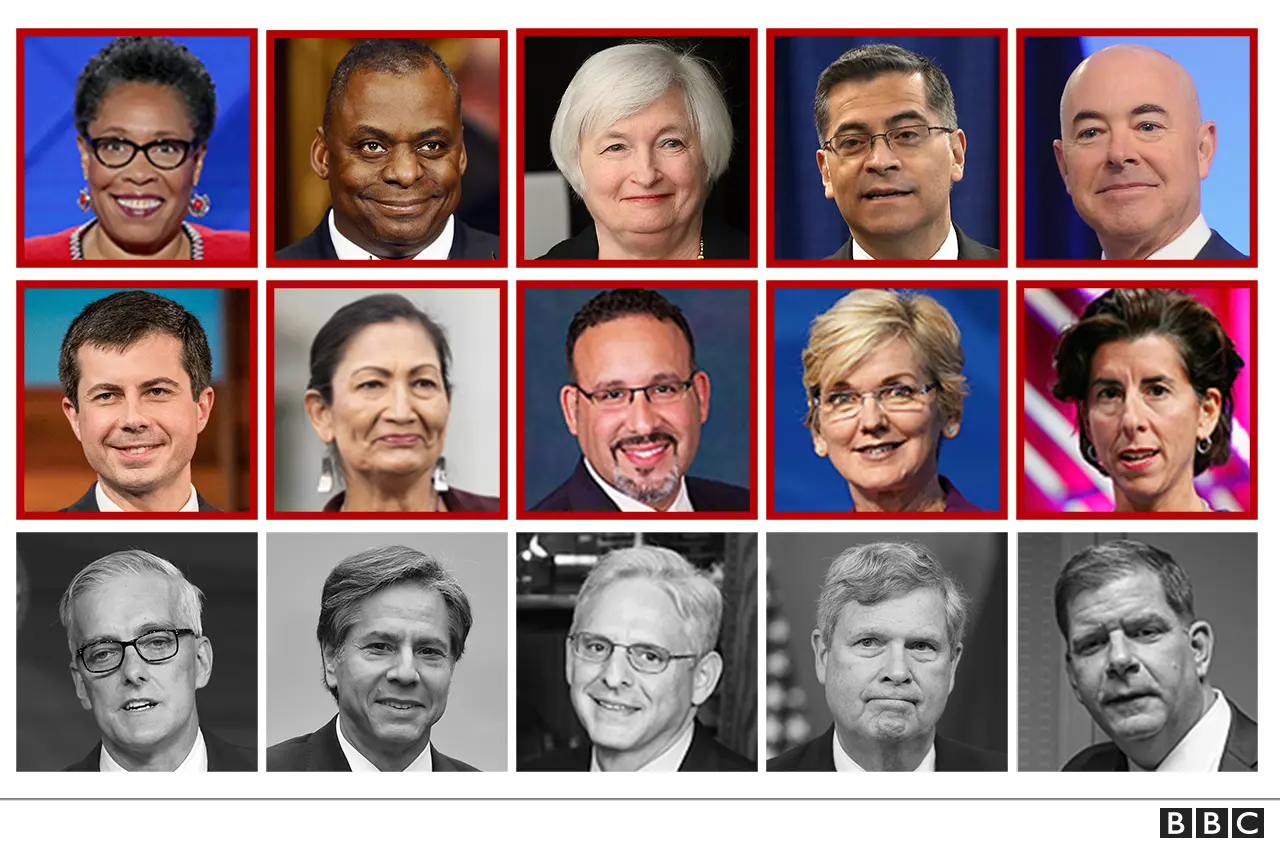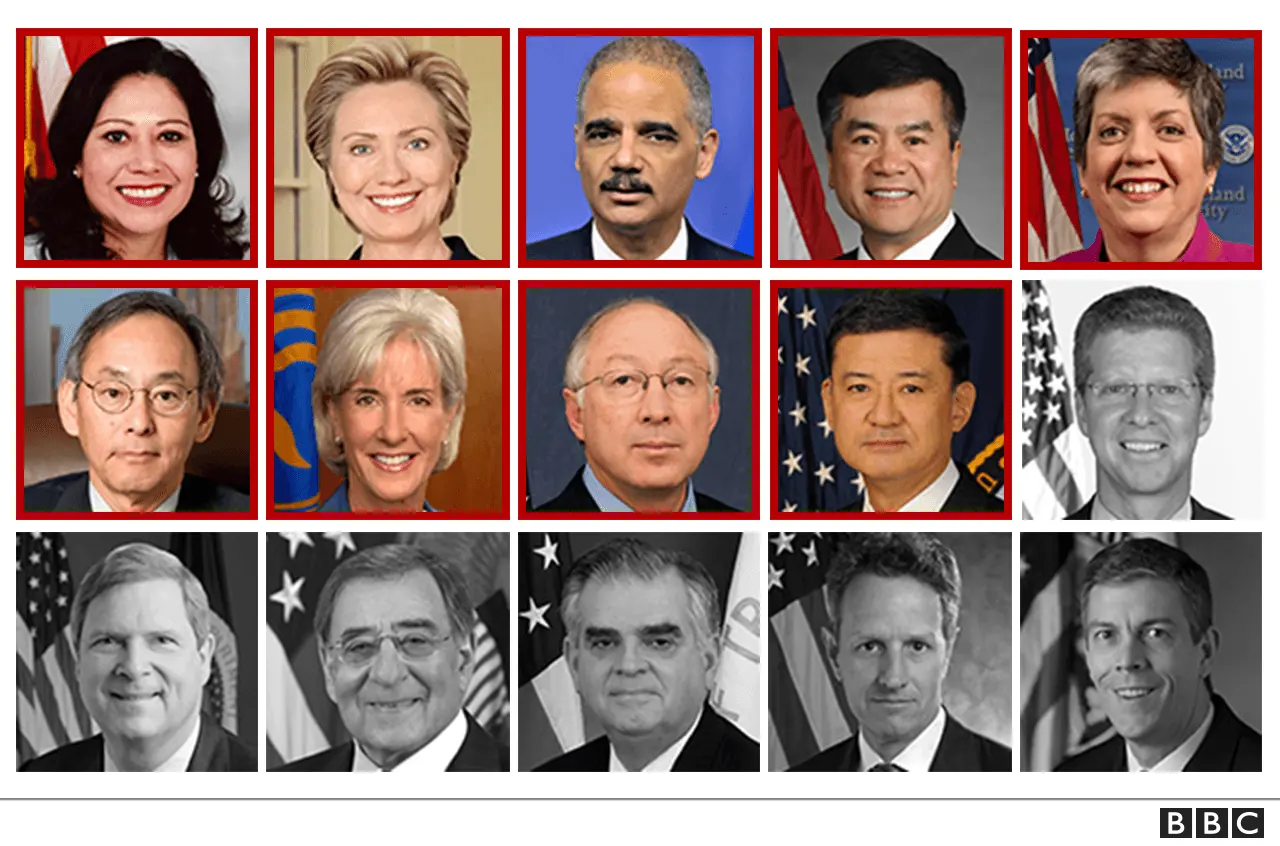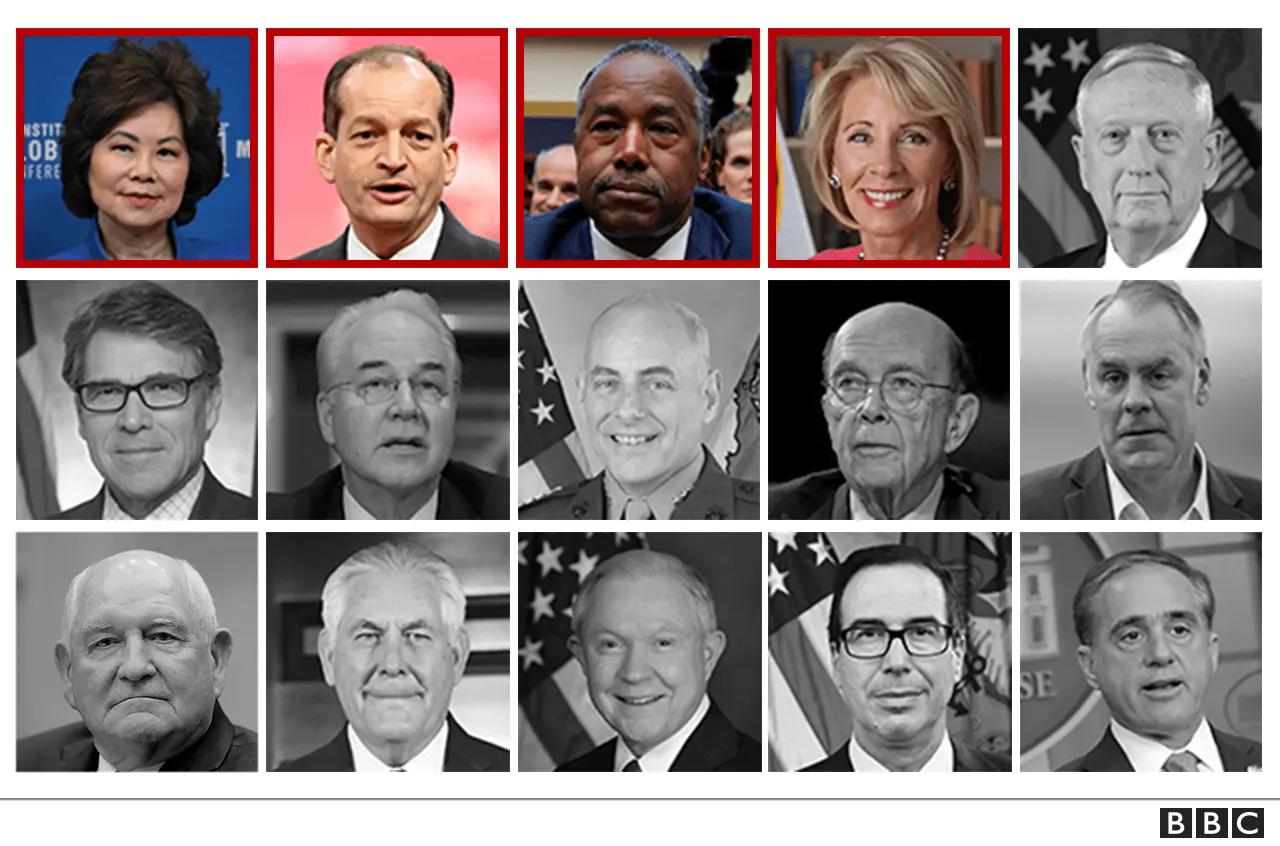Biden cabinet: Does this diverse team better reflect America?
 Getty Images
Getty ImagesPresident Joe Biden's first cabinet is being described as the most diverse ever. The latest historic first is an openly gay cabinet secretary.
When George Washington convened the first cabinet meeting two centuries ago - though he didn't call it by that name - he enshrined the idea of promoting diverse perspectives at the heart of US government. Of course, back in 1791, all the voices in the room were white and male.
You won't find the cabinet mentioned in the lines of the Constitution, but the first president saw the value of advisers who could guide him on major issues while bringing different viewpoints to the table.
In 2021, America has seen its first openly gay cabinet secretary in Pete Buttigieg - the latest Biden confirmation - as well as its first female treasury secretary, first black Pentagon chief and more.
Mr Biden has been under pressure from all sides to deliver on his promises of a cabinet that truly reflects the country rather than a line-up of familiar political faces.

The Biden appointees

The graphic above shows all of Mr Biden's nominees - those with black and white photos are white men, while those with colour photographs are in one or more of these categories: women; people belonging to ethnic minorities; member of the LGBT community.
"This cabinet will be more representative of the American people than any other cabinet in history," Mr Biden told reporters in December.
If approved by the Senate, it will include Congresswoman Deb Haaland as the first Native American cabinet secretary in US history and Miguel Cardona, who is of Puerto Rican heritage, as his education chief.
Mr Biden's first cabinet is even more diverse than that put together by Barack Obama, who came close to truly reflecting the country but fell short with seven women to 16 men, and just one black secretary.
But not everyone has been pleased with his choices. When Mr Biden chose General Lloyd Austin to lead the Pentagon - the first black man to do so - other activists were upset that the position was yet again denied to a woman. And Mr Biden picked two white men to head the state and agriculture agencies - Anthony Blinken and Tom Vilsack - when progressive groups would rather have seen him nominate black women to the roles.
Progressive liberals have also criticised Mr Biden's selections as too safe, too moderate, too establishment and too old. For many of the supporters who delivered Mr Biden the presidency, he's not there just yet.

Since 1933, only 11 presidents have named women to cabinet-level positions. No cabinets have ever matched the gender or racial balance of the country.
The cabinet size can vary depending on administration, but they're roughly composed of around 15 executives. In the last 30 years, the trend has been towards greater representation - or at least it was, until the Trump administration.
The 1993 Clinton administration

On the day of President Bill Clinton's inauguration, the Washington Post wrote that the new Democratic leader had assembled "the most diverse Cabinet in history: five women, four blacks and two Latinos".
Mr Clinton's small business administrator Aida Alvarez was the first-ever Latina appointed to a cabinet-level position.
The 2001 Bush administration

President George W Bush's first cabinet was lauded by the New York Times as "a governing team every bit as ethnically and racially diverse as President Clinton's".
Mr Bush chose Colin Powell, the son of Jamaican immigrants, to become the country's first black secretary of state. He also tapped Norman Mineta - a Democrat who became the first Asian American to hold a cabinet-level spot under Mr Clinton - to head his transportation department.
Later on, the Bush administration made history again with the appointment of Condoleezza Rice: the first black woman to serve as secretary of state and then as national security adviser. Mr Bush also placed the first Pacific Islander and Asian American woman, Elaine Chao, in a cabinet role as labour secretary.
The 2009 Obama administration

President Barack Obama's history-making first cabinet was dubbed a "majority-minority". Mr Obama's inner circle had seven women, nine minorities and just eight white men.
Under Mr Obama, Susan Rice became the first black woman to serve as US ambassador to the United Nations, and Eric Holder became the first black US attorney general.
The 2016 Trump administration

In a throwback to the Reagan era, President Donald Trump's inner circle was notably white, affluent and male - though he had more women in his White House than previous Republicans.
And Mr Trump did appoint women to other roles in the administration. He named the first Indian-American, Nikki Haley, as UN ambassador.
Slow progress
But why has it taken this long for women and minorities to make it into the room where decisions happen?
"When we think about how you get to these roles, one way is to come through elected office," says Professor Kelly Dittmar of the Rutgers University Center for American Women and Politics.
"So if you have a dearth of women and women of colour in elective office, and that's where presidents are looking, in part, to identify cabinet officials, then you already start with an uneven pool."
We saw the first woman in US Congress in 1916, she explains, but it took nearly two more decades before President Franklin Roosevelt appointed the first woman to a cabinet role (that was Labor Secretary Frances Perkins).
The story for black and other ethnic minority Americans has taken even longer. The first black man took a seat in Congress in 1870, but we didn't see a black man in the cabinet until President Lyndon Johnson appointed Robert Weaver in 1966. It took until 1968 for the first black woman to be elected to Congress. The first black woman in the cabinet followed in 1977 (Patricia Roberts Harris, Housing Secretary).
The US has no formal rules requiring equal representation for these groups in government, either.
Countries with quotas in government or at the political party level have made strides towards equality at leadership levels. For example, Rwanda in 2018 saw 61% women in its lower chamber.
The holdouts
In three key posts, the Defence, Treasury, and Veteran's Affairs departments, there has never been a woman in the job - until now.
On 25 January, Janet Yellen was confirmed as Treasury Secretary, breaking that particular glass ceiling.
Old time stereotypes have given way in this sector. Surveys show people nowadays are more likely to rate the genders equal when it comes to handling the economy.
Prof Dittmar says there are more persistent stereotypes about men versus women's expertise when it comes to defence and national security matters, and public opinion polls have shown this divide. Women weren't allowed in the military until 1948.
"Even though we have certainly seen greater diversification, these fields are among the most male dominant, especially at the highest levels," says Prof Dittmar. "There's all sorts of biases going on within those structures to prevent women's advancement, I'm sure. That helps explain why those gaps have been there at least historically."
Why does a (diverse) cabinet matter?
Ohio State University political science and gender studies Professor Wendy Smooth says these appointments are a way of signalling broader initiatives and values - inextricably tied to policy, but also indicators of identity.
"One of the early ways that a presidential administration expresses that willingness to be accountable is through cabinet picks," Prof Smooth says.
"These are the first acts that demonstrate the will of the administration, the spirit of the administration, the values of the administration. It's an identity moment. It's going to be the who we are as the Biden administration and who we are interested in connecting with in the American public."
It may be difficult to directly measure the importance of symbolism, but turning preconceived notions of leadership upside down can have very tangible implications.
"If you see a woman as secretary of defence for the first time, does that start to disrupt expectations that men are better and more expert in areas of defence? Yes, inevitably it does," Prof Dittmar says.
She says the same is true for Vice-President Kamala Harris and her history-making appointment.
"I hope that after her tenure as vice-president, the next time we have women running for president that these questions about electability or qualifications or capability will be at least fewer than they were."
And research from an increasingly diverse Congress has shown that women bring priorities and issues to the table that may otherwise have been ignored. "And that, ultimately, is better for making policy that better speaks to the experiences of the population that they serve," Prof Dittmar explains.
"Unless you can tell me that living your life as a woman or as a black woman or as a South Asian woman in the United States is the same as living your life as a white man, then I don't at all understand why we wouldn't expect that to make a difference in the lens through which they see policy."


Around the world...
- In November, New Zealand Prime Minister Jacinda Ardern also announced a new history-making cabinet. Out of the 20 individuals, five are indigenous Maori and eight are women. One, Nanaia Mahuta, will become New Zealand's first ever female foreign minister. Ms Ardern has also appointed Grant Robertson as the first openly gay Deputy Prime Minister.
- Last year, UK Prime Minister Boris Johnson chose a record number of ministers from ethnic minorities - the most racial diversity at the table in British history.
- In 2015, Canada's Prime Minister Justin Trudeau won praise for naming a cabinet that for the first time had equal numbers of men and women as well as racial diversity. In his words: "Because it's 2015."

Additional reporting by Silvia Martelli.
